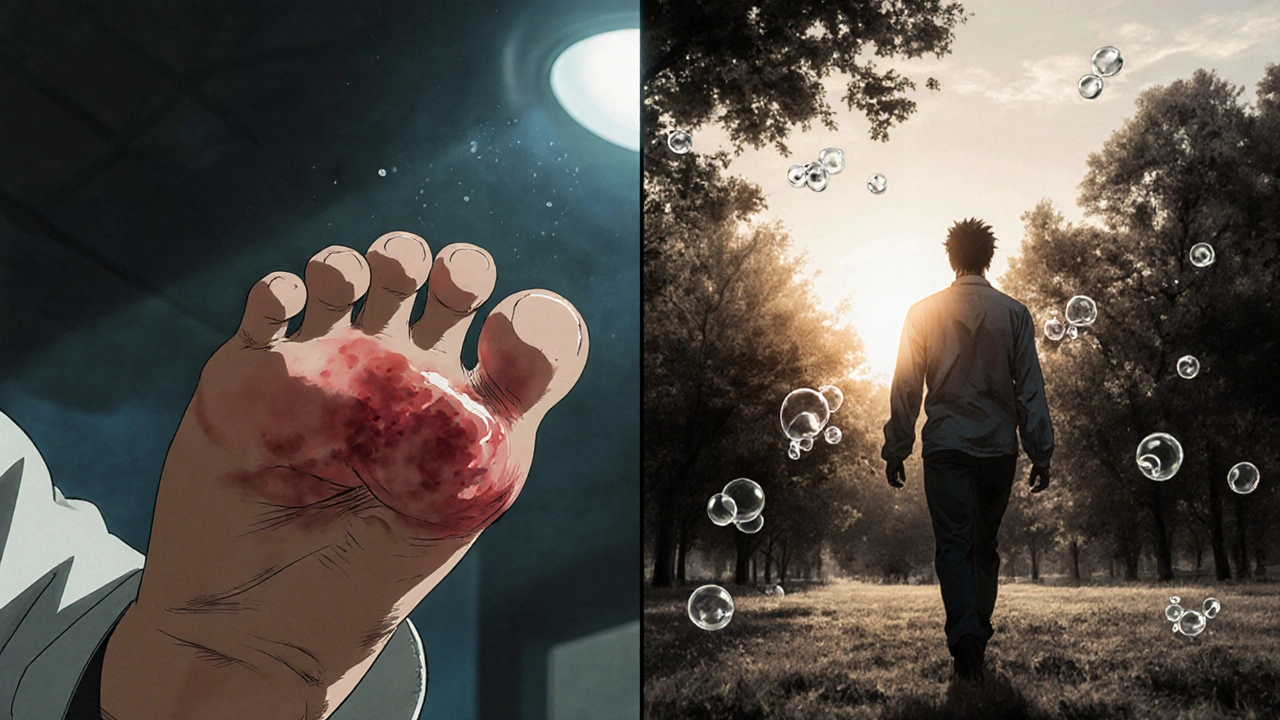Every year, millions of people wake up with a red, swollen, burning joint-often their big toe-and wonder what hit them. For many, the answer is gout, a painful form of arthritis caused by too much uric acid in the blood. When uric acid crystals form in the joints, the body reacts like it’s under attack. Inflammation spikes. Pain explodes. And that’s where allopurinol comes in. It doesn’t numb the pain. It doesn’t flush out crystals. It stops the problem at the source.
What Is Allopurinol?
Allopurinol is a xanthine oxidase inhibitor, a type of medication designed to reduce the production of uric acid in the body. First approved by the FDA in 1966, it’s now one of the most commonly prescribed drugs for chronic gout and hyperuricemia. Unlike painkillers or anti-inflammatories, allopurinol doesn’t treat flare-ups-it prevents them.
It’s not a quick fix. You won’t feel better the first day you take it. In fact, some people have more flare-ups at the start, because as uric acid levels drop, crystals begin to dissolve and stir up inflammation. But over weeks and months, the frequency and severity of attacks drop sharply. Studies show that consistent use of allopurinol reduces gout flares by 70% or more within a year.
How Does Allopurinol Work?
To understand allopurinol, you need to know where uric acid comes from. Your body breaks down purines-natural substances found in your cells and in foods like red meat, shellfish, and beer. When purines are metabolized, they turn into uric acid. Normally, your kidneys filter it out and send it through urine.
But in some people, the body either makes too much uric acid or can’t clear it fast enough. That’s hyperuricemia. When levels stay high for too long, uric acid crystallizes in joints, tendons, and surrounding tissues. That’s gout.
Allopurinol steps in by blocking an enzyme called xanthine oxidase. This enzyme is the final step in turning purines into uric acid. By inhibiting it, allopurinol cuts uric acid production by about 70-80%. The purines don’t disappear-they turn into two other compounds: hypoxanthine and xanthine. These are much more soluble and easier for the kidneys to flush out.
Think of it like turning off a faucet instead of mopping up a flood. You’re not removing the water already on the floor-you’re stopping more from pouring in.
Why This Matters for Gout Patients
Most people think gout is just about diet. Cut out the beer, skip the steak, and you’re fine. But genetics play a bigger role than most realize. Up to 90% of people with gout have a genetic tendency to produce too much uric acid or excrete too little. Diet can trigger flare-ups, but it rarely causes the underlying condition.
That’s why lifestyle changes alone often aren’t enough. Allopurinol targets the root cause. For someone with frequent gout attacks-say, two or more per year-doctors recommend starting allopurinol not to relieve pain, but to prevent future damage. Left untreated, repeated gout attacks can erode cartilage, cause bone damage, and lead to tophi-painful lumps of crystals under the skin.
Research from the British Journal of Rheumatology shows that patients who take allopurinol regularly for five years reduce their risk of joint destruction by 60%. The drug doesn’t just make you feel better-it protects your body long-term.
Dosing and How Long It Takes to Work
Allopurinol is usually started at a low dose-100 mg per day-to avoid triggering a flare-up. For people with kidney problems, the starting dose may be even lower. The goal is to slowly lower uric acid levels so the body doesn’t panic.
It can take three to six months before you notice fewer attacks. During that time, your doctor might also prescribe a low-dose colchicine or NSAID to prevent flare-ups as crystals dissolve. Don’t stop allopurinol if you have a flare-up. That’s when you need it most.
The target uric acid level is below 6 mg/dL. Once you reach that, your body starts dissolving existing crystals. For people with tophi, it can take over a year to fully clear them. Patience is part of the treatment.

Side Effects and Who Should Avoid It
Most people tolerate allopurinol well. Common side effects include mild rash, upset stomach, or drowsiness. But there’s one serious risk: allopurinol hypersensitivity syndrome. This rare reaction-occurring in less than 0.1% of users-can cause fever, blistering skin, liver damage, and kidney failure.
People of Han Chinese, Thai, or Korean descent have a higher genetic risk for this reaction due to the HLA-B*58:01 gene variant. Testing for this gene is now recommended before starting allopurinol in these populations. In the UK, the NHS advises testing for high-risk groups, especially if you’re from Southeast Asia.
If you develop a rash, fever, or swelling while taking allopurinol, stop the drug and see a doctor immediately. Don’t wait. This isn’t a typical allergy-it can turn deadly fast.
What to Expect When You Start
When you first begin allopurinol, you might feel like it’s making things worse. That’s normal. As uric acid levels drop, crystals begin to shift. Your immune system reacts to these moving particles like foreign invaders. That’s why many patients get a flare-up in the first few weeks.
Doctors now know this is a sign the drug is working. The trick is to manage it. Most prescribe a low-dose anti-inflammatory like colchicine for the first three to six months. This keeps the inflammation down while your body adjusts.
It’s also important to drink plenty of water-2 to 3 liters a day. This helps your kidneys flush out the extra hypoxanthine and xanthine, and prevents kidney stones, which can form when uric acid levels are changing.
How Allopurinol Compares to Other Uric Acid-Lowering Drugs
| Medication | How It Works | Typical Starting Dose | Time to Effect | Key Risks |
|---|---|---|---|---|
| Allopurinol | Blocks xanthine oxidase, reduces uric acid production | 100 mg/day | 3-6 months | Hypersensitivity syndrome, rash |
| Febuxostat | Also blocks xanthine oxidase, but stronger | 40 mg/day | 3-6 months | Higher heart risk in some patients |
| Probenecid | Helps kidneys excrete more uric acid | 250 mg twice daily | 3-6 months | Not for people with kidney stones or poor kidney function |
| Pegloticase | Breaks down uric acid directly (IV only) | 8 mg every 2 weeks | Weeks | Severe allergic reactions, very expensive |
Allopurinol remains the first-line choice for most patients because it’s affordable, well-studied, and effective. Febuxostat is used when allopurinol doesn’t work or causes side effects. Probenecid only helps if your kidneys are still working well. Pegloticase is reserved for severe, treatment-resistant cases.

What You Can Do to Make Allopurinol Work Better
Medication alone isn’t enough. Allopurinol works best when paired with smart habits:
- Drink at least 2.5 liters of water daily to help flush out waste products
- Avoid sugary drinks, especially those with high-fructose corn syrup-they boost uric acid production
- Lose weight if you’re overweight. Each kilogram lost can lower uric acid by about 0.5 mg/dL
- Limit alcohol, especially beer and spirits. Wine has less impact, but moderation still matters
- Choose low-purine proteins like eggs, low-fat dairy, and tofu over red meat and organ meats
Studies show that people who combine allopurinol with these changes cut their gout flare-ups in half compared to those who only take the pill.
When to Talk to Your Doctor
You should call your doctor if:
- You develop a rash, fever, or swollen lymph nodes
- You have pain or blood in your urine
- Your gout flares get worse after starting allopurinol
- You miss doses regularly and want to know how to get back on track
- You’re planning surgery or starting a new medication
Allopurinol interacts with some drugs, including azathioprine and certain antibiotics. Always tell your doctor what else you’re taking-even over-the-counter supplements.
Long-Term Outlook
Allopurinol isn’t a cure, but it’s a powerful tool. For many, it turns gout from a recurring nightmare into a manageable condition. People who stick with it often go years without a flare-up. Some even get their tophi to shrink or disappear entirely.
The key is consistency. Take it every day, even when you feel fine. Don’t stop because you’re “cured.” Uric acid levels will rise again, and crystals will come back.
With time, many patients find they can reduce their dose. But that’s something only your doctor should decide, based on regular blood tests. Most need to stay on allopurinol for life-but that’s a small price to pay for pain-free days.
Can I take allopurinol if I have kidney disease?
Yes, but your dose will likely be lower. Allopurinol is cleared by the kidneys, so if your kidney function is reduced, your doctor will adjust the dose to avoid buildup. Regular blood tests to check creatinine and uric acid levels are essential. Many people with mild to moderate kidney disease take allopurinol safely for years.
Is allopurinol the same as colchicine?
No. Colchicine treats gout flare-ups by reducing inflammation. Allopurinol prevents flare-ups by lowering uric acid production. They’re often used together: allopurinol for long-term control, colchicine for short-term flare management.
How long do I need to take allopurinol?
Most people take it for life. Stopping it-even if you haven’t had a flare for years-will cause uric acid to rise again, and crystals will reform. Only in rare cases, like after successful tophi removal and sustained low uric acid levels for over a year, might a doctor consider a slow, supervised taper.
Can I drink alcohol while taking allopurinol?
You can, but it’s not recommended. Alcohol-especially beer and spirits-raises uric acid levels and can trigger flare-ups. Even if you’re on allopurinol, drinking heavily can make the drug less effective. Moderate wine (1 glass a day) is generally safer, but total avoidance is best for people with frequent gout.
What happens if I miss a dose?
If you miss one dose, take it as soon as you remember. If it’s almost time for your next dose, skip the missed one. Don’t double up. Missing occasional doses won’t cause an immediate flare, but regular missed doses can let uric acid creep back up. Set a daily reminder on your phone to stay on track.
Final Thoughts
Allopurinol doesn’t make you feel better right away. But if you stick with it, it gives you back control. It turns a condition that used to dictate your life-limiting your diet, your travel, your sleep-into something you manage, not fear. It’s not glamorous. It’s not a miracle. But for millions of people with gout, it’s the difference between constant pain and quiet, pain-free days.




Dade Hughston
October 31, 2025 AT 22:04so i started allopurinol last year and holy shit it was a nightmare at first like my toe was on fire for two weeks straight i thought the drug was poisoning me but my doc said keep going so i did and now like 14 months later i haven’t had a single flare and i ate a whole lobster tail last weekend like a normal human being bruh
Jim Peddle
November 1, 2025 AT 03:44Let’s be real. Allopurinol is just a pharmaceutical distraction. The real cause of gout is glyphosate in our food supply, and the FDA has known this since 1998. The drug doesn’t fix the root-it just masks it while the industry profits. You think your ‘lowered uric acid’ is a win? You’re just another cog in the machine.
S Love
November 1, 2025 AT 19:43For anyone new to allopurinol: stay the course. It’s not magic, but it’s science. The first few months are rough-your body’s cleaning house. Drink water, take your colchicine as prescribed, and don’t panic when you feel worse before you feel better. This isn’t a sprint. It’s a lifelong habit shift. You’re not just treating gout-you’re reclaiming your life.
Pritesh Mehta
November 2, 2025 AT 07:55Western medicine is so reductionist. You think uric acid is the enemy? In Ayurveda, gout is vata-pitta imbalance caused by modern diets and emotional toxicity. Allopurinol suppresses symptoms like a bandage on a severed artery. True healing requires panchakarma, turmeric, and abandoning processed sugar. Why do you think Indians have lower gout rates? Because we eat real food, not corporate poison. Your pill is a colonial crutch.
John Concepcion
November 3, 2025 AT 20:09lol so you’re telling me i need to drink 3 liters of water and avoid beer for the rest of my life just so i don’t feel like my toe is being stabbed by a rusty nail? cool cool. and how much does this thing cost? because i’m pretty sure my insurance won’t cover it if i’m still drinking soda and eating pizza. this is why i hate modern medicine
Caitlin Stewart
November 4, 2025 AT 17:51I’ve been on allopurinol for 5 years. I used to miss work every other month. Now I hike, travel, even go to BBQs without fear. It’s not glamorous. But it’s freedom. And yes, it took patience. But you’re worth the wait.
Emmalee Amthor
November 6, 2025 AT 13:39people act like allopurinol is some kind of miracle drug but honestly its just buying time until your body gives up completely i mean think about it we’re just chemically suppressing a signal our body’s been screaming for years like maybe the real problem is that we’re living like machines not humans
Leslie Schnack
November 6, 2025 AT 17:28Has anyone here had a reaction to allopurinol and gotten tested for HLA-B*58:01? I’m curious because I’m Asian-American and my doctor didn’t mention it. Just wondering if it’s standard practice here or if I should push for it.
Saumyata Tiwari
November 7, 2025 AT 16:15How can you trust a drug developed by Western pharmaceutical giants who care more about patents than people? In India, we’ve managed gout for centuries with neem, giloy, and dietary discipline. Allopurinol is a Band-Aid on a bullet wound. Your body is not a machine to be patched. It’s a sacred system. You are surrendering your autonomy to corporate science.
Anthony Tong
November 8, 2025 AT 09:50According to CDC data, the rise in gout incidence correlates directly with the increase in high-fructose corn syrup consumption since 1980. Allopurinol is a symptom-management tool, not a solution. The real failure is public health policy that permits sugar-laden beverages to be sold in every corner store. Blame the food industry, not the patient.
Roy Scorer
November 9, 2025 AT 07:32You think you’re doing the right thing taking this pill? You’re just delaying the inevitable. Your body is screaming for you to change your life-to stop being lazy, to stop eating like a trash compactor, to stop treating your health like a vending machine. Allopurinol doesn’t forgive you for your choices. It just lets you keep making them. And that’s the real tragedy.
Marcia Facundo
November 11, 2025 AT 00:11I started this after my third flare-up. I didn’t believe it would work. I’m still not sure. But I take it anyway. Maybe because I’m tired of crying in the ER.
Ajay Kumar
November 12, 2025 AT 05:44Everyone here is acting like allopurinol is the only option. What about cherry juice? Or baking soda? Or fasting? Or acupuncture? Or just… not eating meat? You’re all so quick to swallow a pill but won’t touch a real change. The real gout epidemic is a crisis of willpower, not biochemistry. Your body isn’t broken. You are.